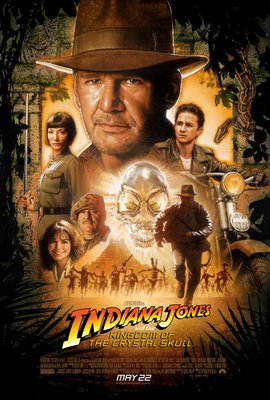Indiana Jones and the Crystal Skull

I really, really wanted to love this film. After all, the first and third Indiana Jones movies are among my all-time favorites, and the producers did a great job of approximating the style of the earlier films. Harrison Ford handles his gently aging role with aplomb, as does Karen Allen. But this installment stumbles badly, and I think the ways in which it stumbles have something to teach writers.
Warning: If you haven’t seen the movie, some of my remarks might be considered spoilers. But there’s nothing here I didn’t see coming a mile away. Which leads me to fault #1:
Predictability. You might say this is an inevitable product of the genre, but I don’t think so. Remember those great reversal moments in THE LAST CRUSADE, when Sean Connery uses his umbrella to send up the seagulls and crash the plane? When we learn that Dr. Elsa Schneider is working for the Nazis? That she slept with the senior Dr. Jones? Or in THE LOST ARC, when the evil Gestapo agent holds up his palm to say “Heil Hitler,” and we see that the imprint of Marion’s medallion was burned into his hand? The fourth installment has none of those moments.
Stereotypical characters. CRYSTAL SKULLS has a character who is sort of a compilation of Sallah, Belloq, and Schneider. Needless to say, he doesn’t work, and I had to look up his name before I could even remember what it was (Mac). I have read raves of Cate Blanchett’s depiction of her character, Irina Spalko. Perhaps she did the best she could with what she had to work with, but in my opinion, her character hit one evil note and held it through the entire movie. She wasn’t interesting, she wasn’t fun, she was just…a stereotype. Yawn. The interaction between Indie and the boy, Mutt, had some good moments, but I kept thinking they could have done so much more with it, while the bits with Marion were so hackneyed and clichéd they made me squirm.
Plot development. Nothing much happens in this movie. It felt like half of the screen time was taken up by one long chase through the jungle. And while it was fun at first, it eventually just felt…long. Plus, while it may be a Hollywood convention to have the bad guys shooting endlessly at the good guys and still missing, this scene was by far—BY FAR—the worst I have ever scene. It went beyond improbable or silly, and just became hopelessly contrived. And boring. Because if they’re that bad of shots, there’s no danger, right?
Plot holes. Where does one start? Like, why did the American government need an archaeologist to help them deal with an alien? Or, why were those conquistadores buried in a tomb with all their loot? I could go on and on and on, but I won’t because it would give too much away. All I’ve got to say is, They take twenty years to write a script, with the “best” people in Hollywood working on it, and they can’t do better than this?
But the most damning flaw in the entire movie was this: Lack of a powerful forward thrust. It could have been there—it should have been there—but it wasn’t. At one point—I believe it was when they were crawling around in the cemetery—I actually found myself thinking, “Now, what are they here for again? What’s the whole point of this movie?”
Ouch.
Labels: Crystal Skull, screenwriting, writing


